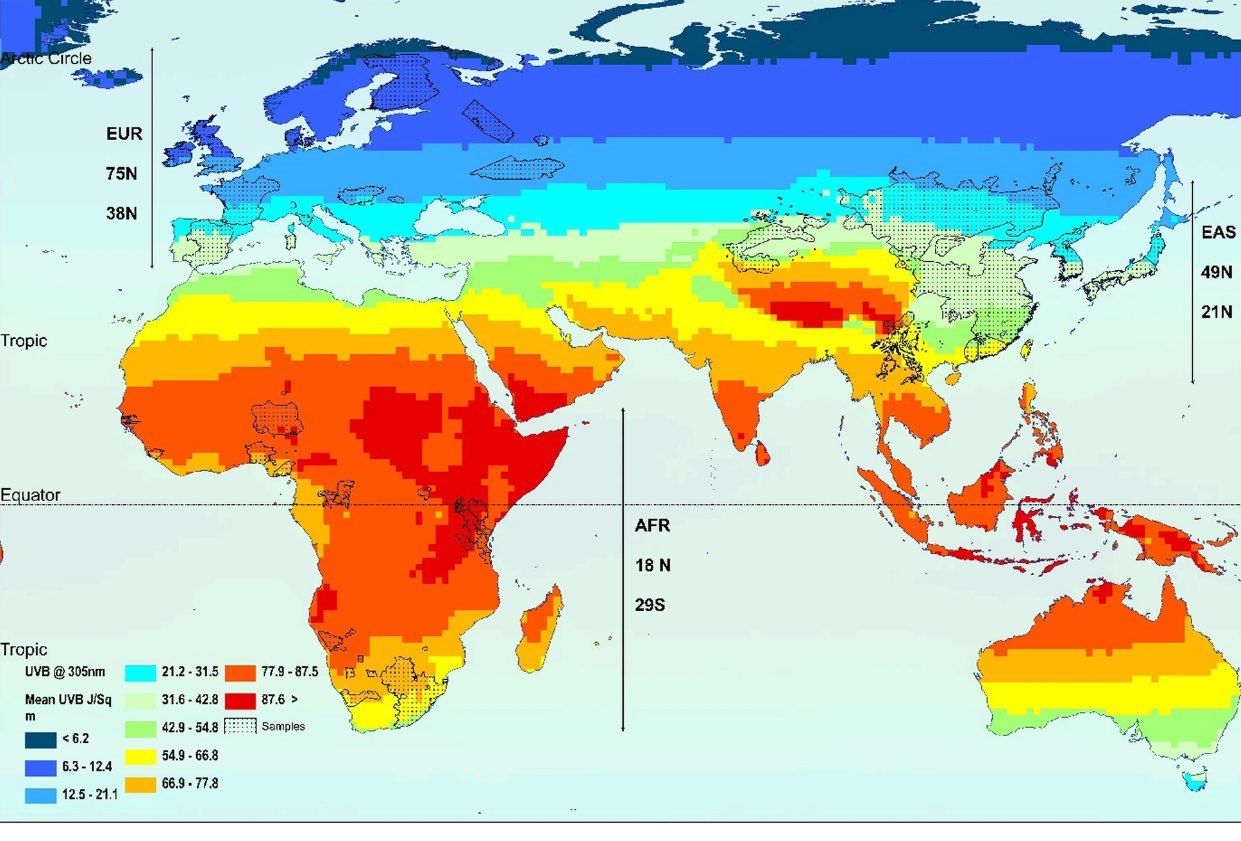Vitamin D levels are correlated with 6 environmental variables in China

Spatial distribution differences of 25-hydroxyvitamin D in healthy elderly people under the influence of geographical environmental factors
Sci Rep. 2022 Jul 27;12(1):12781. doi: 10.1038/s41598-022-17198-9
Wenjie Yang 1, Miao Ge 2, Yabo Wang 1, Xinrui Pang 1, Congxia Wang 3
The main targets of this were to screen the factors that may influence the distribution of 25-hydroxyvitamin D [25(OH)D] reference value in healthy elderly people in China, and further explored the geographical distribution differences of 25(OH)D reference value in China. In this study, we collected the 25(OH)D of 25,470 healthy elderly from 58 cities in China to analyze the correlation between 25(OH)D and 22 geography secondary indexes through spearman regression analysis. Six indexes with significant correlation were extracted, and a ridge regression model was built, and the country's urban healthy elderly'25(OH)D reference value was predicted. By using the disjunctive Kriging method, we obtained the geographical distribution of 25(OH)D reference values for healthy elderly people in China.
The reference value of 25(OH)D for healthy elderly in China was significantly correlated with the 6 secondary indexes, namely,
latitude (°),
annual temperature range (°C),
annual sunshine hours (h),
annual mean temperature (°C),
annual mean relative humidity (%), and
annual precipitation (mm).
The geographical distribution of 25(OH)D values of healthy elderly in China showed a trend of being higher in South China and lower in North China, and higher in coastal areas and lower in inland areas. This study lays a foundation for further research on the mechanism of different influencing factors on the reference value of 25(OH)D index. A ridge regression model composed of significant influencing factors has been established to provide the basis for formulating reference criteria for the treatment factors of the vitamin D deficiency and prognostic factors of the COVID-19 using 25(OH)D reference value in different regions.
📄 Download the PDF from Vitamin D Life
Variables considered

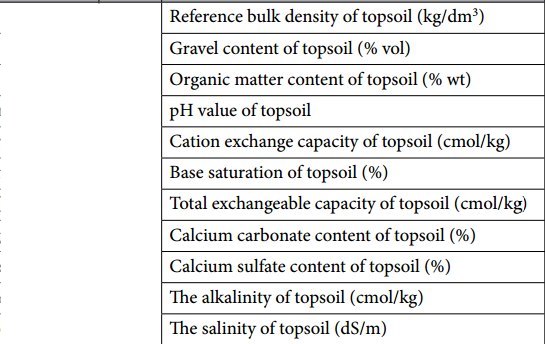
Spacial Distribution (?)
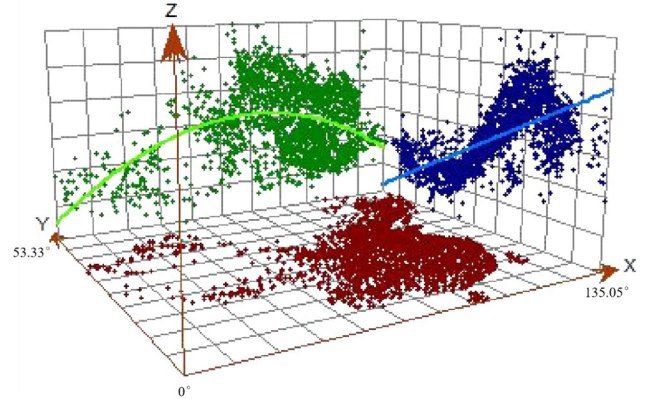
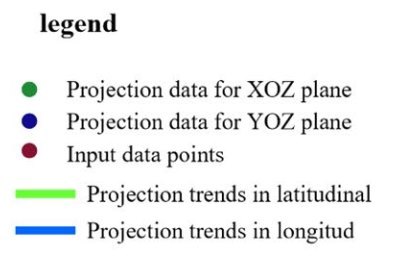
Conclusions
The reference value of 25(OH)D in the Chinese elderly is related to 6 geographical factors. The ridge regression model established in this study can predict the reference value of 25(OH)D in different regions. If the latitude (°), annual temperature range (°C), annual sunshine duration (h), annual mean temperature (°C), annual mean relative humidity (%), and annual precipitation (mm) are known in a certain area.
According to the equation:
Y = 56.51 - 0.25Xi - 0.0075X2 - 0.28X3 - 0.10X4 + 0.0019X5 + 0.059X6 ± 9.06
 Annual sunshine is the most important
Annual sunshine is the most important
The 25(OH)D reference value can be predicted.
Vitamin D in China has a spatial distribution differences trend of high in the south and low in the north. The elderly in the North should pay more attention to vitamin D supplements.
References
Daneshkhah, A., Eshein, A., Subramanian, H., Roy, H. K. & Backman, V. The role of vitamin D in suppressing cytokine storm in Covid-19 patients and associated mortality. medRxiv 18, 1–23 (2020).
Cherrie, M. et al. Ultraviolet a radiation and Covid-19 deaths in the USA with replication studies in England and Italy. Br. J. Dermatol. 2, 246–247 (2021).
Liu, D. et al. UVA irradiation of human skin vasodilates arterial vasculature and lowers blood pressure independently of nitric oxide synthase. J. Investig. Dermatol. 134, 1839–1846 (2014). - PubMed - DOI
Weller, R. B., Wang, Y., He, J., Maddux, F. W. & Kotanko, P. Does incident solar ultraviolet radiation lower blood pressure?. J. Am. Heart Assoc. 9, e13837 (2020). - DOI
Weller, R. B. Sunlight has cardiovascular benefits independently of vitamin D. Blood Purif. 41, 130–134 (2016). - PubMed - DOI
Weller, R. B. The health benefits of UV radiation exposure through vitamin D production or non-vitamin D pathways. Blood pressure and cardiovascular disease. Photochem. Photobiol. Sci. 16, 374–380 (2020). - DOI
Mackay, D. F. et al. UVA and seasonal patterning of 56 370 myocardial infarctions across Scotland, 2000–2011. J. Am. Heart Assoc. 8, e12551 (2019). - DOI
Minshu, Z. et al. Vitamin D induces nitric oxide production in endothelial cells cultured in vitro. Chin. Clin. J. Pract. Paediatr. 13, 1001–1004 (2014).
Yan, L. et al. Older people in China and the United Kingdom differ in the relationships among parathyroid hormone, vitamin D, and bone mineral status. Bone 33, 620–627 (2003). - PubMed - DOI
Wat, Z. M. et al. Prevalence and impact of vitamin D insufficiency in southern Chinese adults. Ann. Nutr. Metab. 5, 59–64 (2007). - DOI
Wenzhong, Z. Indicator systems and methods for the evaluation of inner-city living environments. Geogr. Sci. 27, 7–9 (2007).
Yang, S., Ge, M., Li, X. & Pan, C. The spatial distribution of the normal reference values of the activated partial thromboplastin time based on Arcgis and Geoda. Int. J. Biometeorol. 64, 770–790 (2020). - DOI
Pordanjani, S. R., Kavousi, A., Mirbagheri, B., Shahsavani, A. & Etemad, K. Spatial analysis and geoclimatic factors associated with the incidence of acute lymphoblastic leukemia in Iran during 2006–2014: An environmental epidemiological study. Environ. Res. 202, 111662 (2021). - PubMed - DOI
Jiang, Q. W. & Fei, Z. Application of spatial autocorrelation method in epidemiology. Zhonghua liuxingbingxue zazhi 32, 539 (2011). - PubMed
Utley, M. et al. Correlation analysis versus Bland–Altman analysis: Comment on the article by Genant. Arthritis Rheum. 42, 1557–1558 (2010). - DOI
Pan, C., Wang, H., Guo, H. & Pan, H. How do the population structure changes of China affect carbon emissions? An empirical study based on ridge regression analysis. Sustain. Basel 13, 3319 (2021). - DOI
Meng, Y. F. & Liang, J. Y. Regression analysis for functional data based on least squares support vector machine. Pattern Recogn. Artif. Intell. 27, 1124–1130 (2014).
Taylor, K. E. Summarizing multiple aspects of model performance in a single diagram. J. Geophys. Res. Atmos. 106, 7183–7192 (2001). - DOI
Simo, M. L., Videiro, P. M., Silva, P., Paulo, D. & Sagrilo, L. Application of Taylor diagram in the evaluation of joint environmental distributions’ performances. Mar. Syst. Ocean Technol. 15, 151–159 (2020). - DOI
Ohyver, M., Moniaga, J. V., Sungkawa, I., Subagyo, B. E. & Chandra, I. A. The comparison firebase realtime database and Mysql database performance using Wilcoxon signed-rank test. Proc. Comput. Sci. 157, 396–405 (2019). - DOI
Xiao, Y. et al. Geostatistical interpolation model selection based on Arcgis and spatio-temporal variability analysis of groundwater level in Piedmont Plains, Northwest China. Springerplus 5, 425 (2016). - PubMed - PMC - DOI
Han, C., Liu, J. & Wang, Z. Evaluation of community earth system model in simulating Asian summer monsoon precipitation. J. Meteorol. Sci. 37, 151–160 (2017).
Holick, M. F. Vitamin D deficiency. New Engl. J. Med. 357, 266–281 (2007). - PubMed - DOI
Hossein-Nezhad, A. & Holick, M. F. Vitamin D for health: A global perspective. Mayo Clin. Proc. Mayo Clin. 88, 720–755 (2013). - PubMed - DOI
Ganji, V., Zhang, X. & Tangpricha, V. Serum 25-hydroxyvitamin D concentrations and prevalence estimates of hypovitaminosis D in the U.S. population based on assay-adjusted data. J. Nutr. 142, 498–507 (2012). - PubMed - DOI
Greene-Finestone, L. S. et al. 25-Hydroxyvitamin D in Canadian adults: Biological, environmental, and behavioral correlates. Osteoporosis Int. 22, 1389–1399 (2011). - DOI
Gonzalez-Gross, M. et al. Vitamin D status among adolescents in Europe: The healthy lifestyle in Europe by nutrition in adolescence study. Br. J. Nutr. 107, 755–764 (2012). - PubMed - DOI
Songlin, et al. Is it necessary for all samples to quantify 25OHD2 and 25OHD3 using LC–MS/MS in clinical practice?. Clin. Chem. Lab. Med. (CCLM). 56, 273–277 (2018). - DOI
Li, L. et al. Ethnic, geographic, and seasonal differences of vitamin D status among adults in South-West China. J. Clin. Lab. Anal. 34, 1–9 (2020).
Whiting, S. J. & Calvo, M. S. Dietary recommendations for vitamin D: A critical need for functional end points to establish an estimated average requirement. J. Nutr. 135, 304–309 (2005). - PubMed - DOI
Slominski, A. T. et al. Vitamin D signaling and melanoma: Role of vitamin D and its receptors in melanoma progression and management. Lab. Investig. J. Tech. Methods Pathol. 97, 706–724 (2017). - DOI
Slominski, A. T. et al. The role of Cyp11a1 in the production of vitamin D metabolites and their role in the regulation of epidermal functions. J. Steroid Biochem. Mol. Biol. 144, 28–39 (2014). - PubMed - DOI
Slominski, A. T. et al. The role of classical and novel forms of vitamin D in the pathogenesis and progression of nonmelanoma skin cancers. Adv. Exp. Med. Biol. 1268, 257–283 (2020). - PubMed - PMC - DOI
Slominski, A. T. et al. On the role of classical and novel forms of vitamin D in melanoma progression and management. J. Steroid Biochem. Mol. Biol. 97, 706–724 (2017).
Slominski, A. T. et al. Novel activities of Cyp11a1 and their potential physiological significance. J. Steroid Biochem. Mol. Biol. 151, 25–37 (2015). - PubMed - DOI
Slominski, A. T. et al. Novel vitamin D photoproducts and their precursors in the skin. Dermato-Endocrinology 5, 7–19 (2014). - DOI
Prentice, A., Schoenmakers, I., Jones, K. S., Jarjou, L. & Goldberg, G. R. Vitamin D deficiency and its health consequences in Africa. Clin. Rev. Bone Miner. Metab. 7, 94–106 (2009). - PubMed - PMC - DOI
Anastasiou, A. et al. Ultraviolet radiation and effects on humans: The paradigm of maternal vitamin D production during pregnancy. Eur. J. Clin. Nutr. 71, 1268–1272 (2016). - PubMed - DOI
Chen, T. C. et al. Factors that influence the cutaneous synthesis and dietary sources of vitamin D. Arch. Biochem. Biophys. 460, 213–217 (2007). - PubMed - PMC - DOI
Hedlund, R., Diamond, T. K. & Uversky, V. N. The latitude hypothesis, vitamin D, and SARS-Co-V2. J. Biomol. Struct. Dyn. 17, 1–3 (2020).
Boucher, B. J. Vitamin D status as a predictor of Covid-19 risk in black, Asian and other ethnic minority groups in the UK. Diabetes Metab. Res. Rev. 36, 3375 (2020). - DOI
Çuhacı-Çakır, B. & Demirel, F. Effects of seasonal variation and maternal clothing style on vitamin D levels of mothers and their infants. Turk. J. Pediatr. 56, 475–481 (2014). - PubMed
Holick, M. F. Vitamin D status: Measurement, interpretation, and clinical application. Ann. Epidemiol. 19, 73–78 (2009). - PubMed - DOI
Vitamin D Life - Vitamin D levels around the world - DSM review June 2014
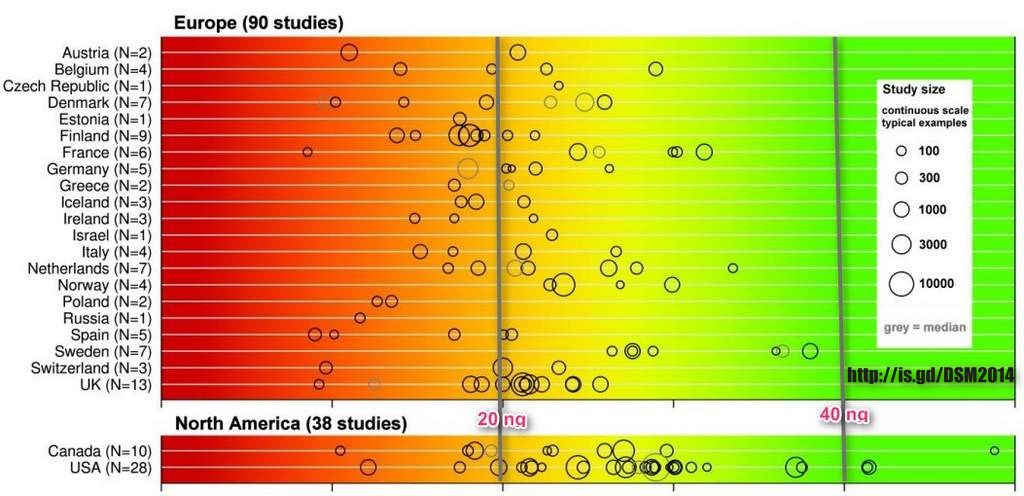

Vitamin D Life - UVB annual US - 1978-2014

Vitamin D Life - UV Map of Europe
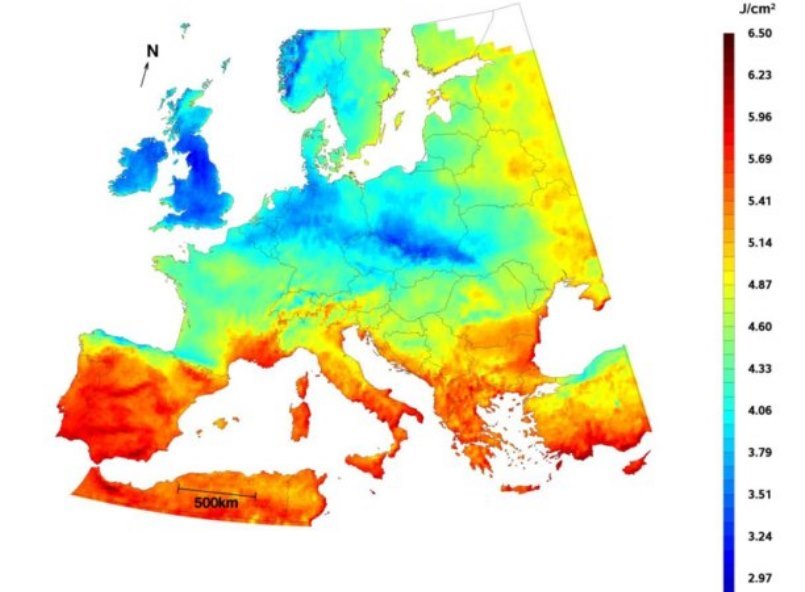
Vitamin D Life - UV Map of Asia
